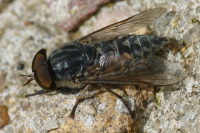Phylum Arthropoda (Arthropods) ➔ Subphylum Hexapoda (Hexapods) ➔ Class Insecta (Insects) ➔ Order Diptera (True flies) ➔ Family Tabanidae (Clegs, deer flies, horse flies)
Tabanus bromius Linnaeus, 1758
Gemeine Viehbremse Band-eyed Brown Horsefly
Synonyms and other combinations:
Straba simplex Muschamp, 1939 | Tabanus anthophilus Loew, 1858 | Tabanus bronicus Gimmerthal, 1847 | Tabanus connexus Walker, 1856 | Tabanus flavofemoratus Strobl, 1909 | Tabanus glaucescens Schiner, 1862 | Tabanus glaucus Meigen, 1820 | Tabanus nigricans Szilady, 1914 | Tabanus scalaris Meigen, 1820 |
Classification:
Tabanus bromius belongs to the subfamily Tabaninae.Distribution:
Europe, North Africa, Central Asia.Habitat:
Often found on pastures and at forest edges.Description:
Body length 13.5 - 15 mm; wing length 10.5 - 11 mm; coloration yellowish grey to almost black; wings clear with brown veins; abdomen with light patches; compound eyes with a band, hairless (or with microscopically small hairs); eyes separated in females, meeting in males; in the males ommatidia in the upper part (2/3 to 3/4) of the eyes 6 times larger than in the lower part.Biology:
The Band-eyed Brown Horsefly Tabanus bromius flies from May to September.Males and females feed on nectar and plant sap. The females need a blood meal for egg maturation and attack various mammal species. Common hosts are cattle and horses. Beside these also humans are attacked.
In a scientific study, it was found that a female of Tabanus bromius must imbibe a minimum of 17 mg blood for the complete maturation of eggs. At least 197 eggs/fly could mature with this amount of blood. The number of eggs asymptotically increased with the amount of blood imbibed. An upper limit of 450 eggs/fly was reached for 60 mg of blood.
References, further reading, links:
- Pape T. & Thompson F.C. (eds) (2017). Systema Dipterorum (version 2.0, Jan 2011). In: Species 2000 & ITIS Catalogue of Life, 2017 Annual Checklist (Roskov Y., Abucay L., Orrell T., Nicolson D., Bailly N., Kirk P.M., Bourgoin T., DeWalt R.E., Decock W., De Wever A., Nieukerken E. van, Zarucchi J., Penev L., eds.). Digital resource at www.catalogueoflife.org/annual-checklist/2017. Species 2000: Naturalis, Leiden, the Netherlands. ISSN 2405-884X.
- Michael Chinery: Pareys Buch der Insekten: über 2000 Insekten Europas, Verlag Kosmos, 2004, 326 Seiten, ISBN 3440099695, 9783440099698.
- E. Völlger, M. Jeremies: Bestimmungsschlüssel für mitteleuropäische Bremsen (Dipt., Tabanidae), Entomologische Nachrichten und Berichte, 29, 1985/1, 1-11.
- Stjepan Krčmar, Davorka K. Hackenberger, Branimir K. Hackenberger: Key to the horse flies fauna of Croatia (Diptera, Tabanidae); Periodicum Biologorum, Vol. 113, Suppl 2, 2011, ISSN 0031-5362.
- Martin Grassberger: Tabanidae (Bremsen), in: H. Aspöck (Hrsg.): Krank durch Arthropoden, Denisia 30 (2010): 261–266.
- M. Mally und E. Kutzer: Zur Tabanidenfauna Österreichs und Betrachtungen zu ihrer medizinischen Bedeutung, Mitt. Österr. Ges. Tropenmed. Parasitol. 6 (1984) 97-103.
- J. W. 0. Ballard and J. K. Waage: Feeding strategies of the horseflies Hybomitra expollicata and Tabanus bromius in southern France, Medical and Veterinary Entomology (1988) 2, 265-270.








